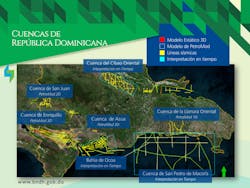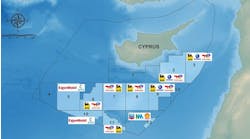Offshore staff
SANTO DOMINGO, Dominican Republic – The Ministry of Energy and Mines reported six areas of the national territory with geological information interpreted by state-of-the-art software, which could be the starting point for in-depth research on probable hydrocarbon deposits.
Minister Antonio Isa Conde, during an event aimed at informing the results of a 2D seismic survey and petroleum system modeling of certain areas of the Dominican Republic, explained that “the purpose of these studies [is] for scientists, environmentalists, companies, investors and civil society to take full advantage of them.”
He underlined that sharing this information will help open a debate on what the potential for hydrocarbons is, and what would be convenient to do with the wealth of hydrocarbons that might exist in the subsurface.
The areas with the largest potential belong to the Enriquillo, Azua, San Juan, Ocoa (offshore), San Pedro (offshore) and East Cibao basins, with faults and structures that could work as hydrocarbon-retaining traps that still require more in-depth studies to arrive at definitive conclusions.
The studies were conducted bySchlumberger, and suggest that the locations of greatest interest for further in-depth seismic surveys are in Enriquillo, Azua, San Juan, and San Pedro.
The Enriquillo basin “has defined traps that coincide with source rocks, where the Sombrerito and Plaisance rocks are in the oil-generating window,” Isa Conde observed. As for the Azua basin, “high structures operating as hydrocarbon reservoirs were determined, and coincide with the Ocoa and Jura source rocks, which are in the oil-generating window,” he added.
“Developing the hydrocarbon potential must be undertaken with due responsibility and, therefore, before making this information publicly available, we developed a regulation to establish clear-cut standards for future exploration activities,” Isa Conde stated.
He defined the endeavors of the government of Danilo Medina to make hydrocarbon information freely and openly available, and noted that this measure was both unprecedented and of critical importance.
Meanwhile, the Deputy Minister for Hydrocarbons, Alberto Reyes, commented that the interest of the ministry was neither to create false expectations nor to elicit newspaper headlines. He said that addressing the question on whether there is oil in the country is complex, because new information, in-depth analysis, and given geological conditions are required.
The activity held by the ministry to offer blocks with oil exploration potential was attended by representatives of diplomatic delegations, academic institutions, business associations, oil and electric power companies, as well as members from organized civil society entities.
The Schlumberger report recommends conducting further in-depth analysis and seismic data acquisition or processing, and suggests this be attained through:
- Acquisition of new seismic surveys, focusing on the areas identified as having potential
- Using this new seismic interpretation to identify subsurface objectives to drill deep exploratory wells and collect lithological and chronostratigraphic information, as well as temperature, pressure, and porosity records.
This, in turn, will enable government and members of industry to identify deeper generation levels, and perform geochemical analysis to define the quality of TOC source rocks. This new information will allow geoscientists and exploration firms to update existing petroleum system models.
Schlumberger was awarded a bid in December 2014 by the Ministry of Energy and Mines to create the National Hydrocarbon Database (BNDH, per its acronym in Spanish) and advise the institution on this topic. The agreement was signed in March 2015 and the BNDH was delivered in 2016.
11/02/2016



